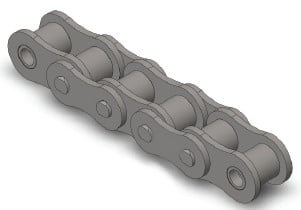The following ways should really be used to select chain and sprocket sizes, determine the minimal center distance, and calculate the length of chain necessary in pitches. We are going to primarily use Imperial units (such as horsepower) on this segment even so Kilowatt Capability tables can be found for every chain size within the preceding segment. The assortment technique will be the identical irrespective on the units employed.
Phase 1: Determine the Class with the Driven Load
Estimate which in the following greatest characterizes the ailment in the drive.
Uniform: Smooth operation. Tiny or no shock loading. Soft start out up. Reasonable: Typical or reasonable shock loading.
Heavy: Severe shock loading. Regular starts and stops.
Step two: Figure out the Services Aspect
From Table 1 under decide the acceptable Services Component (SF) for that drive.
Step three: Calculate Style and design Electrical power Requirement
Design and style Horsepower (DHP) = HP x SF (Imperial Units)
or
Layout Kilowatt Power (DKW) = KW x SF (Metric Units)
The Style and design Power Necessity is equal for the motor (or engine) output power times the Support Factor obtained from Table 1.
Step 4: Produce a Tentative Chain Assortment
Produce a tentative variety of the demanded chain size while in the following method:
1. If employing Kilowatt energy – fi rst convert to horsepower for this phase by multiplying the motor Kilowatt rating by one.340 . . . This is often important since the swift selector chart is shown in horsepower.
2. Locate the Layout Horsepower calculated in phase 3 by reading through up the single, double, triple or quad chain columns. Draw a horizontal line as a result of this value.
3. Locate the rpm with the compact sprocket within the horizontal axis in the chart. Draw a vertical line as a result of this value.
4. The intersection of your two lines ought to indicate the tentative chain assortment.
Stage five: Select 
Once a tentative variety of the chain size is manufactured we need to figure out the minimum quantity of teeth expected on the little sprocket needed to transmit the Design and style Horsepower (DHP) or even the Layout Kilowatt Energy (DKW).
Stage six: Determine the amount of Teeth to the Huge Sprocket
Use the following to determine the quantity of teeth for that large sprocket:
N = (r / R) x n
The quantity of teeth over the large sprocket equals the rpm in the compact sprocket (r) divided through the desired rpm of your large sprocket (R) instances the number of teeth over the tiny sprocket. In the event the sprocket is too significant for your space out there then multiple strand chains of a smaller pitch should be checked.
Phase seven: Figure out the Minimum Shaft Center Distance
Utilize the following to calculate the minimal shaft center distance (in chain pitches):
C (min) = (2N + n) / 6
The over is a guide only.
Step eight: Test the Final Selection
Moreover be aware of any prospective interference or other area limitations that could exist and change the selection accordingly. In general one of the most efficient/cost eff ective drive makes use of single strand chains. This is certainly simply because many strand sprockets are a lot more high priced and as may be ascertained from the multi-strand components the chains come to be significantly less effi cient in transmitting energy as the quantity of strands increases. It’s as a result generally most effective to specify single strand chains whenever attainable
Step 9: Identify the Length of Chain in Pitches
Use the following to calculate the length from the chain (L) in pitches:
L = ((N + n) / 2) + (2C) + (K / C)
Values for “K” could possibly be discovered in Table four on web page 43. Bear in mind that
C will be the shaft center distance offered in pitches of chain (not inches or millimeters and so on). When the shaft center distance is identified within a unit of length the value C is obtained by dividing the chain pitch (inside the same unit) through the shaft centers.
C = Shaft Centers (inches) / Chain Pitch (inches)
or
C = Shaft Centers (millimeters) / Chain Pitch (millimeters)
Note that anytime doable it is very best to employ an even quantity of pitches in order to avoid the usage of an off set hyperlink. Off sets don’t possess the same load carrying capability because the base chain and should really be averted if doable.
The Drive Chain Selection Procedure
Tags: